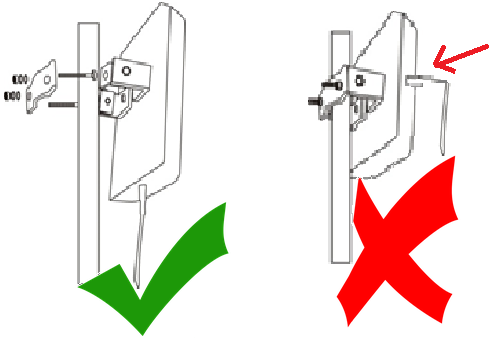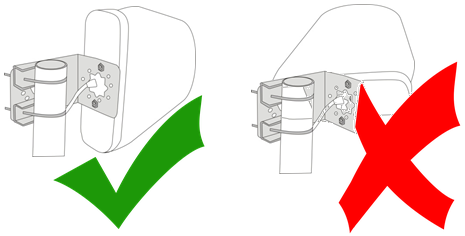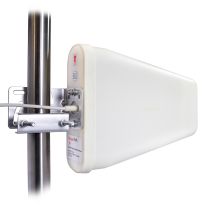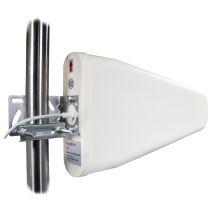
To get the most out of your GSM amplifier, it is essential to be able to pick up the best possible external signal. In fact, there is nothing magical about a GSM amplifier: it merely re-amplifies existing waves; it does not create anything new. Keep this golden rule in mind: the better the incoming signal, the better the performance of the repeater/amplifier within a given environment.
The outdoor antenna is the very first aspect to pay attention to. It is not complicated at all, it is enough to respect some parameters that we will describe below. This short reading (about 3-5 minutes) will certainly save you time when installing.
- Make a temporary installation
- Finding the best signal outside
- Locating the nearest radio base stations (BTS)
- Maintain good insulation between the outdoor and indoor antennas
- Principle of self-oscillation (signal looping)
- Solution to self-oscillation by distance
- Solution to self-oscillation by mass
- Other possible solutions
- Fix and orient the outdoor antenna
1. Make a temporary installation
That's the secret to a successful installation of your GSM amplifier kit: do a test installation! You will have plenty of time later to collect the cables and get everything set up.
Place your antennas temporarily first, with the coaxial cables not yet placed in their final housing. Connect all the elements and then turn on your GSM amplifier to see if everything is working normally.
- Is everything okay? No self-oscillation and the signal on the phone has improved? Then the antenna placement is perfect. You are all set!
- Is there self-oscillation? Is the signal not being picked up correctly? We will then have to find the best location for the antenna(s).
2. Finding the best signal outside
To ensure optimal operation of your GSM amplifier, you can measure the signal level using your cell phone: you can use the notch indication on the screen, or, better yet, read the exact value of the external signal, expressed in dBm. This second option is preferred as it is more detailed; you can find all the explanations in this article.
Note: Since this is a negative scale we must reason in reverse: the best signal is given by the smallest negative number, closest to 0 dBm. For example, -46 dBm is much better than -102 dBm.
Try with your smartphone to stand at different points on the roof (or at the highest point of the house). The spot that offers the best signal is where you will install the outdoor antenna.
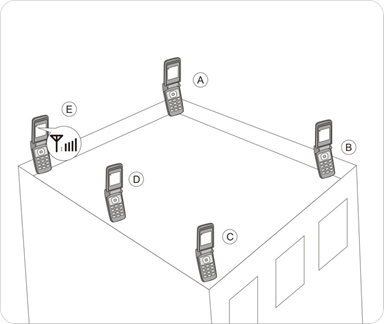
However, you can use applications for the purpose of checking the presence of cellular signal and thus ensure that a GSM amplifier will be a good investment:
for iPhone: Cellular Network Signal Finder (downloadable from Apple Store)
for Android: NetMonitor Cell Signal Logging (downloadable from Google Play Store)
3. Locating the nearest radio base stations (BTS)
The outdoor antenna of the GSM amplifier should be oriented toward the radio base station (BTS). Ideally, the BTS should be "in sight" direct, as unobstructed as possible from your antenna.
A directional outdoor antenna is generally used in rural areas. Easy to point to the BTS, make sure that the signal (waves) is not obstructed by dense forested areas or other types of obstacles. The BTS must necessarily be in sight with this type of antenna.
n an urban area, where BTS stations are more numerous and closer, an outdoor panel antenna is generally used. Capable of capturing the signal in a wider radius, pointing this antenna is easier, but it is still important.
4. Maintain good insulation between the outdoor and indoor antennas
It is a matter of preventing the antennas from picking up each other, otherwise your GSM amplifier will not work properly or at all.
A GSM amplifier is a system that receives, amplifies, and re-emits. Each antenna, whether indoor or outdoor, alternately receives and emits. If two antennas are too close together, the Larsen effect that musicians are familiar with occurs: the sound from the microphone is amplified, diffused into the speaker ... and then is re-echoed by the microphone and so on. All this causes an annoying whistling sound and will eventually ruin the equipment.
In the case of GSM amplifiers we talk about self-oscillation instead of Larsen, but it is the same principle and has the same consequences, the possible deterioration of the device.
Your repeater/amplifier has automatic adjustments that allow it to adjust the gain directly. It is still possible to adjust the gain manually thanks to the attenuator on the back, but the power of the repeater will be affected.
Let's take the example of the whistle that a microphone makes in front of a speaker: if we turn the volume down too much to dampen it, at some point we won't have any volume at all, leaving the audience empty-handed!
Therefore, the solution is to increase the distance between the microphone and the speakers and thus avoid this phenomenon.
4.1 Principle of self-oscillation (signal looping)
When your antennas interfere your GSM amplifier is no longer able to function properly. At best it goes into self-protection mode until it is rebooted. At worst, it fails. Here is the explanation of the self-oscillation phenomenon.
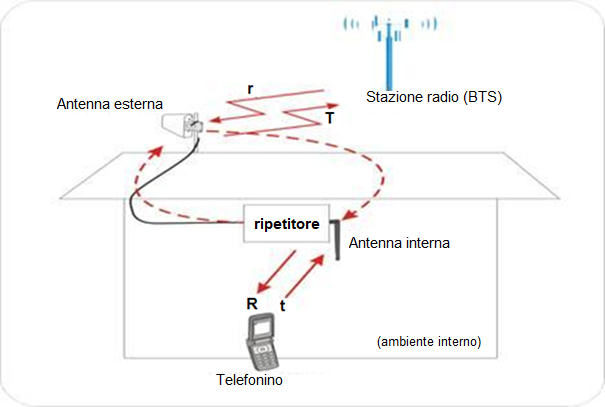
As depicted in the drawing, the external antenna takes the descending signal (r) from the radio station and sends it to the repeater. The re-amplified signal (R) is sent to the indoor antenna. If the distance between these two antennas is insufficient, the re-amplified signal (R) is re-captured by the outdoor antenna.
Same for the uplink signal traveling to the radio station: the re-amplified signal (T) is also intercepted by the internal antenna.
It is possible to run for cover by following the following two recommendations: this is what we call antenna isolation.
4.2 Solution to self-oscillation by distance
Separate your antennas as much as possible. Generally speaking, we can say that a distance of 10 meters between the outdoor antenna and the indoor antenna(s) is sufficient to protect against oscillation.
Each amplifier kit includes a 10-meter external coaxial cable: take advantage of it as much as possible. If you need longer cables you can find them on this page.
Note that in the case of systems with two or more indoor antennas, self-oscillation usually comes from the indoor antenna closest to the outdoor antenna.
Sometimes the distance is good, but self-oscillation persists. Then we will have to move on to the next solution, in which materials (glass, walls, wood. etc.) present in the physical space between the two antennas come into play.
4.3 Solution to self-oscillation by mass
We define mass as all matter that is permeable or impermeable to waves. Typically, metal panels, walls (especially of old, very thick construction, made up of nonperforating bricks), reinforced concrete ceilings (containing metal), lead, and metal grids are good materials to take advantage of the mass effect.
These materials, in other words, block the passage of waves and communication between the two antennas, isolating them. Self-oscillation is averted and the GSM amplifier can function at its best!
4.4 Other possible solutions
The two solutions just mentioned can be perfectly combined; indeed, it is a good idea to take advantage of both distance and ground to achieve the best isolation and allow the GSM amplifier to function properly.
However, there are specific cases, due to the peculiar characteristics of the environment, where we cannot do much. Let's look at two examples:
- There is only 6 meters distance between the antennas, but also 2 bearing walls-the danger of self-oscillation is still very low.
- The outdoor antenna is placed not on the roof but on the balcony, on the same floor as the indoor antenna, there is a distance of 10 m and there are 2 wooden doors between the antennas: self-oscillation is more likely.
We also consider the directivity of the antennas: we take into account their propagation zone and make sure, by orienting them, that one does not invade the range of the other. Remember, however, that even a very directive antenna radiates residual waves behind it as well.
5. Fix and orient the outdoor antenna
Depending on your type of outdoor antenna, we leave you with some useful tips. Nothing complicated, a couple of drawings explain better than a long speech!
5.1 Fixing
Extremely easy, you will only need a flat wrench or universal pliers.
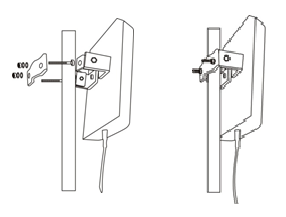
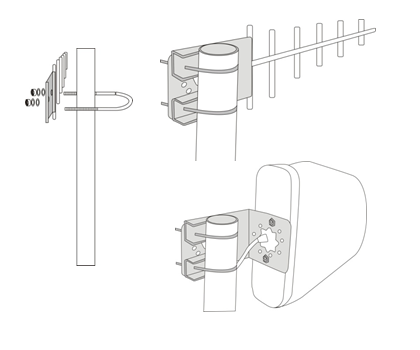
5.2 Toward orientation and polarization
|
|
|
| Always make sure that the wire from the antenna exits downward or upward. If the wire hangs to the left or right the antenna is no longer polarized and will not pick up correctly. | The directional antenna should be placed upright and not lying down, as in the drawing. |
Relative to directional antennas (the fairing models, which we call Yagi Logarithm and Yagi Super), respect the orientation direction marked in red. There is a hole in the bottom of the antenna that allows condensation liquid to escape.

5.3 Orientation toward the radio station
Observe the illustration below.
The large plastic surface of the panel antenna is its "exchange zone." This face should face the nearest radio station. Instead, directional antennas (Yagi Logarithm, Yagi Super) point like an arrow toward the tower.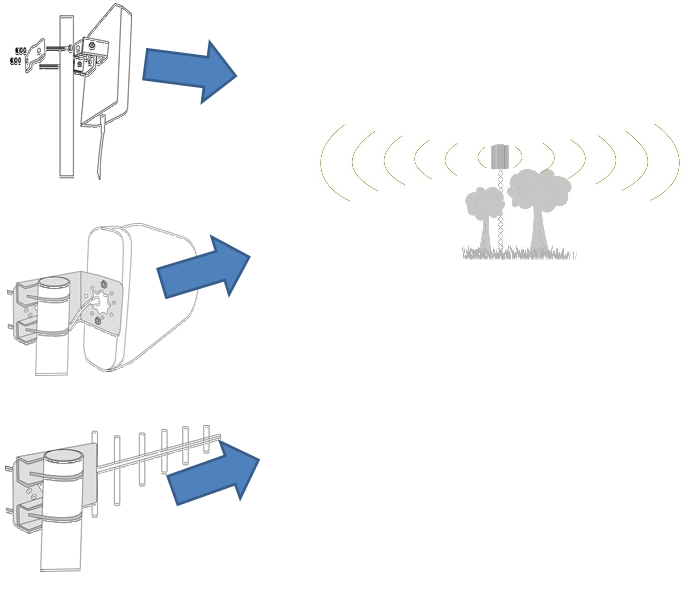
5.4 Beware of obstacles
This is especially important for directional antennas: the tip faces the radio station and the latter is "in sight."
It does not necessarily mean that you should see it with the naked eye, but that the line of sight should be as free as possible from obstacles such as forests, mountains, buildings or other constructions. Let's imagine that we are aiming a laser beam! Can we catch the tower?
5.5 Detail of panel antennas
Outdoor panel antennas are also called semi-homnidirectional antennas because they have a 180-degree aperture. They intercept waves from a wider horizon than their directional antenna colleagues, but they cannot compete on distance. They reach 1-1.5km, to be exact, while a Yagi Super directional antenna picks up up to 12-14km away. In any case, we also address a panel antenna well. A little patience, a little more to the right, a little more to the left, just a few minutes well invested in the future performance of the repeater.
Conclusion
We have seen that for a GSM amplifier there are two major families of antennas for outdoor use: semi-homnidirectional antennas and directional antennas. Each has its own characteristics and limitations. To guide your choice ask yourself first of all:
Are they in the city, with a good outdoor signal or in a rural area with poor outdoor signal because of the few radio stations there?
Write to us at sales@gsm-repeater-shop.com if you have any concerns about this, provide some information about your case, and we will get back to you as soon as possible.
